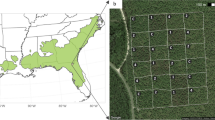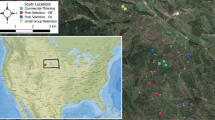Abstract
Canopy wind profiles can often be represented by an exponential function such that wind-speeds in these vegetative canopies are a function of height and the attenuation coefficient of this wind profile relationship. To be more precise, canopy flow is a function of canopy density, element flexibility, and height. An index of canopy flow, therefore, can be defined as a conservative measure of the gross flow response to the presence of various types of roughness elements. For this study, windspeed profile data of two quite different canopy density experiments — field and wind tunnel - have been analyzed based on least-square fittings. The results indicate that the two sets of index values of canopy flow behave in a similar manner with maxima occurring for optimum densities of one-third the potential full array of roughness elements. These index values also differ by some 0.2, but are still compatible when one accounts for the respective levels of turbulence within these dissimilar canopies.
Similar content being viewed by others
References
Allen, L. H.,Jr.: 1965, ‘A Comparison of Airflow Pattern Within and Above Five Different Vegetative Canopies’, 1965 Annual Report of Agricultural Research Service, Ithaca, N.Y.
Allen, L. H. Jr.: 1967, ‘Air Flow and Turbulence Characteristics in a Japanese Larch Plantation’, Research Report No. 395, Agricultural Research Service, Ithaca, N.Y. (AD 662720).
Bendix Corporation: 1963, ‘Jungle Canopy Penetration’, Vegetation and Meteorological Studies II, Ann Arbor, Mi.
Brooks, F. A. and Schultz, H. B.: 1958, ‘Observations and Investigations of Nocturnal Density Currents’, Climatology and Micrometeorology, Proceedings of the Canberra Symposium, UNESCO, Arid Zone.
Cionco, R. M., Ohmstede, W. D., and Appleby, J. F.: 1963, ‘A Model for Air Flow in an Idealized Vegetative Canopy’, Meteorological Research Notes No. 5, USAERDAA, Fort Huachuca, Az (AD 422705).
Cionco, R. M.: 1965, ‘A Mathematical Model for Air Flow in a Vegetative Canopy’, J. Appl. Meteorol. 4, 517.
Cionco, R. M.: 1971, ‘Application of the Ideal Canopy Flow Concept to Natural and Artificial Roughness Elements’, R&D Technical Report ECOM-5372, Atmospheric Sciences Laboratory, USAECOM, White Sands Missile Range, NM.
Cionco, R. M.: 1972, ‘A Wind-Profile Index for Canopy Flow’, Boundary-Layer Meteorol. 3, 255.
Inoue, E.: 1963, ‘On the Turbulent Structure of Airflow Within Crop Canopies’, J. Meteorol. Soc. Sec. II, 41, 317.
Inoue, E., Lemon, E. R., and Denmead, O. T.: 1964, A Preliminary Investigation into the Airflow Within Crop Canopies, unpublished.
Kawatani, T. and Meroney, R. N.: 1968, ‘Structure of Canopy Flow Field’, Fluid Dynamics and Diffusion Laboratory Report CER 67–68-TK-66, Colorado State University, Fort Collins, Co.
Kutzbach, J. E.: 1961, ‘Investigations of the Modification of Wind Profiles by Artificially Controlled Surface Roughness’, Section 7 of Annual Report 1961, Department of Meteorology, University of Wisconsin (AD 273053).
Lemon, E. R., Ordway, D. E., Ritter, A., Spence, D. A., Tan, H. S., Ling, S. D., and Stoller, J.: 1963, ‘The Energy Balance at the Earth's Surface’, Part II, USDA Production Report No. 72, Government Printing Office, Washington, DC (AD 605527).
Nakagawa, Y.: 1965, ‘Studies on the Airflow Amongst the Stalks in a Paddy Field’, J. Agric. Meteorol. 12, 61.
Ohmstede, W. D.: 1964, Wind Profile Data Within and Above a Xmas Tree Canopy, unpublished.
Plate, E. J. and Cermak, J. E.: 1963, ‘Investigations to Develop Wind Tunnel Techniques for Measuring Atmospheric Gaseous Diffusion in Model Vegetative Surface’, Fluid Dynamics and Diffusion Laboratory, Colorado State University, Fort Collins, Co.
Schlichting, H.: 1955, Boundary Layer Theory, Pergamon, New York.
Shinn, J. H.: 1971, ‘Steady-State Two-Dimensional Flow in Forests and the Disturbance of Surface Layer Flow by a Forest Wall’, R&D Technical Report ECOM-5583, Atmospheric Sciences Laboratory, White Sands Missile Range, NM.
Shinn, J. H. and Cionco, R. M.: 1972, ‘A Note on Observations of Turbulence and Mean Flow in Vegetative Canopies’, Proceedings of the Symposium on Air Pollution, Turbulence and Diffusion December 7–10, 1971. Available at ASL, USAECOM, White Sands Missile Range, NM 88002.
Tan, H. S. and Ling, S. C.: 1961, ‘A Study of Atmospheric Turbulence and Canopy Flow’, TAR-TR 611, Cooperative Research program: Therm Advanced Research, Inc., US Department of Agriculture and Cornell University, Ithaca, New York. Also available in Lemon et al., 1963 (AD 605527).
Wright, J. L.: 1965, ‘Evaluating Turbulent Transfer Aero-Dynamically Within the Microclimate of a Cornfield’, Ph. D. Thesis, Cornell University, Ithaca, New York, 174 pp.
Author information
Authors and Affiliations
Rights and permissions
About this article
Cite this article
Cionco, R.M. Analysis of canopy index values for various canopy densities. Boundary-Layer Meteorol 15, 81–93 (1978). https://doi.org/10.1007/BF00165507
Received:
Issue Date:
DOI: https://doi.org/10.1007/BF00165507




